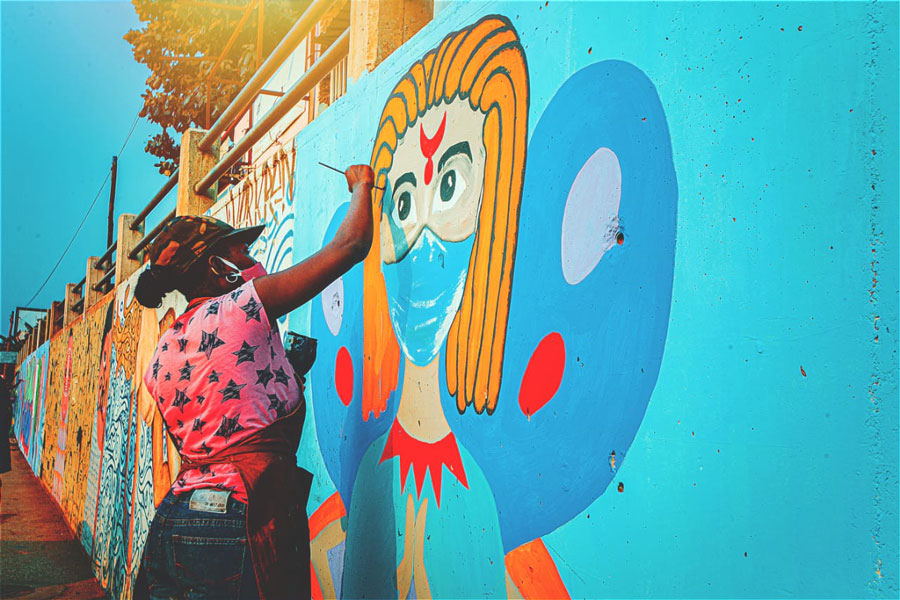The walls speak for the vulnerable in Luanda
Oksanna Dias has been using street art to draw attention to the challenges of the women of Luanda.
- 28 October 2021
- 4 min read
- by Gaspar Micolo

The beaches that lie at the heart of Luanda, Angola’s capital city, have always been postcard-perfect. Sadly, today the beaches are missing the bathers who frequented them. Access to the seven kilometres of beaches that separate the city from the ocean is still prohibited due to COVID-19.
“COVID-19 has destroyed a lot, but I do think that people are realising, especially in the art space, that by being limited to using only what we had in our possession, we could be more creative.”
For the few tourists who are content to enjoy the sea from a distance and frequent the restaurants in the area, there is a mural that, in a way, justifies and emphasises the ban. The mural shows a man supporting planet Earth, protected by the mask.

For designer, painter and graffiti artist Oksanna Dias, who painted the mural, the objective when she conceived the image in September 2020 was clear – it was important to portray one of the prevention methods in the fight against COVID-19.
The 24-year-old Dias, who started on paper before expanding to street art, also sees herself as an important youth activist. The mural, painted on a cabin at Luanda’s endpoint, reflects a lot of her views, in particular what she sees as the need to promote solidarity in a moment of global uncertainty.
She explains: “On the globe, the reason I highlighted the African continent is that, in situations like the one we are going through, there can be no room for racism. We all live on the same planet. We all have the same colour of ‘red’ blood. We all breathe the same air. We all feel pain. This is regardless of social status or privilege.”

Oksanna Dias is a woman who feels the plight of women deeply and often portrays this in her art. She sees art as an opportunity to break away from conformism, and as a means to help others, especially women. When the pandemic hit Angola, she began to better understand the difficulties of the women street vendors (zungueiras), who are among the most vulnerable.
Have you read?
With friends, including artists and activists, they painted murals in various parts of Luanda showing the impact of the pandemic on these women.
“Many of these women were left without income, as they could not sell,” she says. “Due to COVID-19, families were afraid of having someone leave and then returning to the household with COVID-19. This had an impact on the women and many others, including myself. I used to teach at home. For this reason, I intend to raise awareness, through the arts, on the importance of the empowerment of women around the world and, specifically, in Angola!”
Dias sees in these women the typical brave Angolan woman. Every day, they wake up early, buy their products and walk the streets, selling their wares, come rain or shine. They provide for their children’s needs. Many carry their child on their backs while carrying a basin full of products on their head. For these women, street selling is often the only option.
On Samba Road, one of the busiest avenues in Luanda, the mural of an angelic figure draws the attention of motorists and passers-by. Dias says that she painted this mural as a way of asking (praying) for the women sellers to wear the mask.

“The street is the place where I can show the painting process to people, men, women, children, the youth. The interaction with people enchants me!” says Dias.
The pandemic hasn’t taken everything away though. Dias says that recycling has gained more life, as well as handicrafts. Staying at home longer also allowed her to work on other things.
“COVID-19 has destroyed a lot but I do think that people are realising, especially in the art space, that by being limited to using only what we had in our possession, we could be more creative.”
To this end, she is participating in a collective exhibition at Escola Americana about women called "Arte no Peito" (Art in the Breast) where she’s showing work she painted in her studio.
“I love representing African women. It's something I've fallen in love with and I intend to continue showing African beauty, experiences and everyday life.”
More from Gaspar Micolo
Recommended for you







